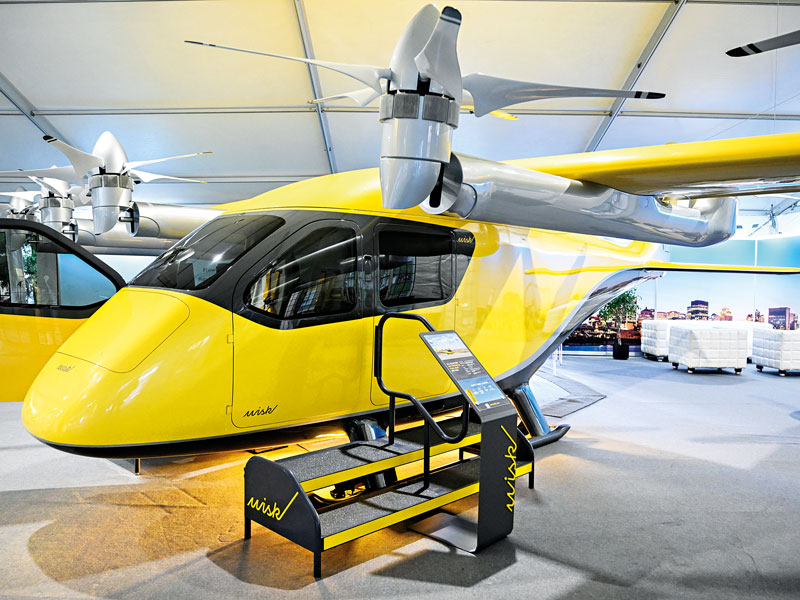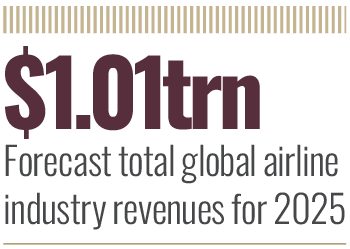
A Wisk self-flying all-electric four-seat air taxi 
Author: Indrabati Lahiri, Features Writer
The global aviation industry has seen a number of developments in the last few years, such as more sustainable and green travel, electric aircraft and better maintenance, repair and overhaul (MRO) technology. The International Air Transport Association (IATA) expects total global airline industry revenues to reach $1.01trn in 2025. If so, this will be the first time that the industry’s revenues surpass the $1trn barrier, while also being a 4.4 percent rise from 2024.
Passenger numbers are likely to touch 5.2 billion this year, which would be an increase of 6.7 percent from last year. Cargo volumes are estimated to rise 5.8 percent on an annual basis and hit 72.5 million tonnes as well. This expected growth in the global aviation sector has led to several aerospace and tech companies attempting to develop autonomous airplanes.
At the moment, major sector giants such as Boeing, Airbus, Lockheed Martin and Northrop Grumman, as well as innovative tech start-ups such as Whisk, Joby and Elroy Air, are working on developing autonomous flight technologies and systems. Countries with strong government funding, sophisticated aerospace ecosystems and strategic defence priorities, such as China, the US and some EU nations, are leading this development.
The timescales involved
Although vehicles with varying degrees of autonomy have become more common recently, fully autonomous cars (level five) are not commercially available to the general public as yet. Similarly, fully autonomous airplanes could still take several years to be available on the open market, although related technologies such as automatic target recognition have been operational for a while now. Autonomous military and speciality unmanned aerial vehicles (UAVs) or drones have also been functional for years. Dan Bubb, aviation historian and associate professor in residence, UNLV Honors College, noted: “There is no doubt aviation technology continues to make giant leaps including in automation. Some businesses predict that autonomous aircraft will dominate aviation by the 2040s. I can envision that in the military, cargo, and general aviation sectors.”
Fully autonomous airplanes could still take several years to be available to the open market
Dr. Walter Stockwell, vice president of Engineering at ANELLO Photonics, also expects autonomous aircraft versions to be more adopted in surveillance, specialised missions and cargo in the near term, with broader commercial passenger applications likely to happen in the next 10–15 years. “Hybrid models combining autonomy with human oversight could be dominating the skies by the early 2030s,” Stockwell said.
The Covid-19 pandemic, ongoing Russia-Ukraine war and Middle Eastern tensions have all contributed to a surge in supply chain bottlenecks and constraints in the last few years. These have led to long shipping delays and detours, a shortage of certain products, as well as significant financial losses.
Autonomous cargo and logistics aircraft have the potential to largely reduce many of these constraints. As such, these could likely be ready for large-scale operations as soon as the next five to 10 years, according to Sylvester Kaczmarek, chief technology officer at OrbiSky Systems. However, one of the main factors affecting the timeline for autonomous aircraft is how long it takes to properly understand the risks around artificial intelligence and autonomy, as well as to bring about the appropriate legislation to regulate this technology.
Disrupting the aviation sector
Autonomous aircraft can enhance decision-making and situational awareness, especially when analysing data with AI. They can also make hazardous area and remote operations easier, while slashing operational costs and having the potential for 24/7 operations. These aircraft could drastically increase efficiency as well, mainly through optimised fuel consumption and flight routes.
Bill Irby, the CEO of AgEagle Aerial Systems, explained: “The potential payoff is huge. Airlines and military organisations have gone through many periods of shortages and surplus of pilots and flight crews. Implementing autonomy could help even out the staffing surges.”
Autonomy could mean that more AI technicians and remote operators are required, rather than pilots, significantly changing the landscape of the aviation labour market. Smaller airline crews overall may become the norm. New business models from urban air taxis to high-frequency cargo drones could potentially transform the aviation industry at every level, according to Stockwell. Other business models include rapid middle-mile cargo and specialised delivery and surveillance airplanes.
Michael Healander, CEO and co-founder of Airspace Link, believes that the immediate impact of autonomous aviation will be seen through drones in areas such as infrastructure inspection, emergency services and agricultural monitoring.
“As the digital infrastructure matures, we will see integration with traditional aviation that will eventually extend to autonomous air taxis that move people as well as goods, revolutionising urban transportation networks while generating new revenue streams for airports and municipalities,” Healander explained. On the other hand, autonomy will also affect air space management, while requiring the entire industry to bring in more regulations relating to safety, security and fair use of technology.
Crunching the numbers
According to a recent report by McKinsey, a number of companies developing autonomous aircraft could potentially need anywhere between $1bn and $2bn for the development, prototyping and testing needed for type certification alone.
Irby noted that some of those investments were already underway. “Several Advanced Air Mobility (AAM)-focused organisations are already investing many millions of dollars in this emerging area. Government offices are engaged as well, and given what has been underway for the last few years in combat zones, it is evident that government tech investments need to increase to develop and field these technologies at a faster pace,” Irby said.
According to Healander, the US is now in a prime position to lead in the higher-value segments of autonomous systems and airspace management infrastructure. However, more investments from US tech giants, logistics and aerospace companies will be needed to speed up this transition. New models of declaring airworthiness and new equipment standards from both government and industry are critical too.
“The countries that will ultimately lead this space will be those that best balance innovation with appropriate regulatory frameworks – creating safe systems for autonomous operations at scale rather than just manufacturing the hardware,” Healander said. To launch autonomous aircraft on a large scale, along with regulatory frameworks, investment also needs to focus on public acceptance and technological infrastructure.
The private sector needs to keep working on detect-and-avoid systems, aircraft design and command-control solutions, among other things. Along with that, public-private partnerships will be key in accelerating this transition. One of the other things required would be advanced inertial navigation systems (INS), which includes next-generation optical gyroscopes. Better AI and autonomous decision-making systems are also needed, which are capable of safety-critical and real-time judgements across the aviation ecosystem.
Looking at the challenges
Along with the significant financial investment needed, one of the main challenges with developing and scaling autonomous aircraft is creating strong detect-and-avoid capabilities that will ensure safety in dynamic and complex environments. Developing the robust digital infrastructure needed to handle millions of daily flights remotely is also difficult.
Irby highlighted: “True machine-learning and autonomy are very complex areas that require tremendous computing power. This is one pacing limitation if edge-autonomy is the intent, given the size-weight-power tradeoff for aircraft.”
With autonomous aircraft, I think it will take longer to convince the public
Irby added: “The other complex area is moral clarity and moral application of autonomy. Nations have differing views on the technologies’ application, especially when considering the preciousness of human life.” Navigating the changing regulatory landscape while retaining public trust can be tricky too, especially when vehicles already offering some autonomous features, like Tesla, continue to face issues.
Bubb said: “How do we regulate autonomous aircraft to ensure they are safe? Given the recent spate of crashes that have taken place, and the deep concern the public has about aviation safety, how do we overcome that concern? With autonomous aircraft, I think it will take longer to convince the public, and we will have to work even harder than we are now.”
However, he pointed out that rapid developments in aircraft technology such as better navigation instruments, aerodynamic efficiency and cabin design are very encouraging.
Real-world testing is also much more difficult for autonomous aircraft than it is for autonomous cars, despite some of their similarities. “A UAV cannot just pull over to the side of the highway if there is a problem – so access to airspace for testing and acceptance of test failures are critical to advancing the technology,” said Stockwell.
Another major issue is cybersecurity protection of autonomous systems, as well as a risk management plan in case of technical issues and outages, especially given the widespread impact of the recent Microsoft and Crowdstrike outage. Cybersecurity can ensure that key tools such as navigation, command links and onboard systems are protected from attacks.
Air traffic integration, which involves managing mixed airspace with manned and autonomous aircraft safely, can be difficult too. “We believe the foundation of successful autonomy lies in navigation technologies that are fault-tolerant, precise, and independent, ensuring autonomous flight is not just possible, but safe and scalable in all environments,” Stockwell concluded. n